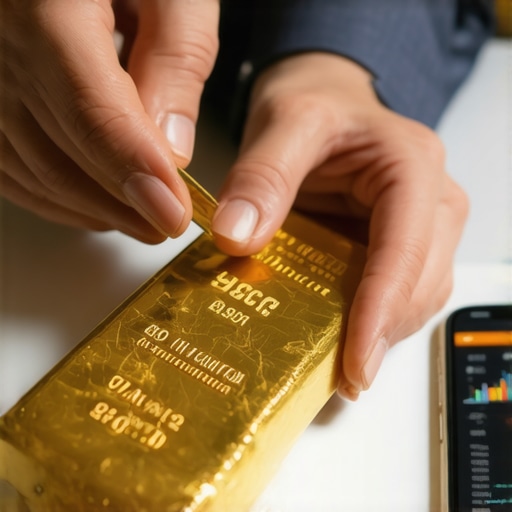Introduction to Gold Investment for Beginners
Investing in gold is a time-tested strategy that has attracted individuals seeking to diversify their portfolios and protect their wealth. Whether driven by economic uncertainty, inflation fears, or simply the allure of precious metals, many new investors are exploring how to incorporate gold into their financial plans. This quick-start guide aims to provide essential insights for beginners interested in investing in gold.
Why Consider Gold as an Investment?
Gold has long been regarded as a safe haven asset. Its value tends to remain stable during economic downturns, making it an attractive option for investors looking to preserve capital. Additionally, gold is a tangible asset, unlike stocks or bonds, providing a sense of security. Whether you’re new to investing or looking to enhance your current portfolio, understanding the benefits of gold can aid in your decision-making process.
Benefits of Investing in Gold
1. Inflation Hedge: Gold often retains its purchasing power during inflationary periods, acting as a hedge against currency devaluation.
2. Portfolio Diversification: Including gold in your investment portfolio can reduce risk and volatility. Gold often performs differently than stocks and bonds, providing balance.
3. Global Demand: Gold is universally recognized and accepted, with demand coming from various sectors including jewelry, technology, and investment.
4. Liquidity: Gold is a highly liquid asset, meaning it can be easily bought or sold, making it practical for both short-term and long-term strategies.
Types of Gold Investments
When considering investing in gold, it’s crucial to understand the different forms it can take:
Physical Gold
Investing in physical gold, such as gold bars or coins, allows you to own the asset directly. This tangible form of gold can provide peace of mind, but it also requires secure storage and insurance.
Gold ETFs and Mutual Funds
Gold Exchange-Traded Funds (ETFs) and mutual funds offer a way to invest in gold without the need to physically store it. These funds typically track the price of gold or invest in gold mining companies, providing an easy way to gain exposure to the gold market.
Gold Mining Stocks
Investing in companies that mine gold can be another avenue. While these stocks can offer higher returns, they also carry specific risks associated with the company’s performance and operational challenges.
Getting Started with Your Gold Investment
To embark on your gold investment journey, consider the following steps:
1. Educate Yourself
Understanding the fundamentals of gold and the factors influencing its price is vital. Resources like Investing in Gold for Beginners: Tackling Common Myths can provide valuable insights.
2. Determine Your Investment Strategy
Decide how much of your portfolio you want to allocate to gold. This will depend on your financial goals and risk tolerance.
3. Choose a Reliable Dealer
If you opt for physical gold, find a reputable dealer to ensure that you’re making a wise investment. Look for dealers with positive reviews and fair pricing.
4. Monitor the Market
Stay updated on gold market trends and price forecasts, such as those outlined in Gold Price Forecast: Key Insights for Astute Investors. This knowledge will help you make informed decisions.
By following these initial steps and understanding the basics of gold investment, you can confidently begin your journey in this enduring market. Remember, investing in gold is not just about the immediate returns but also about the long-term strategy and wealth preservation.
Understanding Gold Investment Risks
As with any investment, investing in gold comes with its own set of risks. It’s essential to be aware of these to make informed decisions. Here are some common risks associated with gold investing:
Market Volatility
The price of gold can be influenced by various factors, including economic conditions, geopolitical events, and changes in currency values. This volatility can lead to sudden price fluctuations, which may affect your investment’s value.
Storage and Security Concerns
If investing in physical gold, consider the costs and logistics of secure storage. Storing gold at home poses risks such as theft or damage, while bank storage may incur fees. Assess the best options for your needs.
Liquidity Issues
While gold is generally a liquid asset, certain forms of gold, like collectibles or rare coins, may not be as easily sold. Understanding the liquidity of your investment is critical for managing your portfolio effectively.
Strategies for Successful Gold Investment
To maximize your returns in gold investments, employing effective strategies is crucial. Here are some strategies to consider:
Dollar-Cost Averaging
This strategy involves regularly investing a fixed amount of money into gold, regardless of its price. This method can help mitigate the impact of market volatility by averaging out your purchase costs over time.
Long-Term Holding
Gold is often viewed as a long-term investment. Rather than trying to time the market, consider holding your gold investments through market fluctuations to benefit from long-term appreciation.
Combining Gold with Other Assets
Integrating gold with other investment types, such as stocks or bonds, can enhance your portfolio’s performance. Diversifying your investments helps reduce overall risk and increases stability.
Keeping Up with Gold Market Trends
Staying informed about market trends is vital for successful gold investment. Follow these tips to keep abreast of changes:
Regularly Review Price Forecasts
Monitoring expert forecasts, such as those from Gold Price Forecast: What Investors Should Know, can provide insights into potential market movements and help you make informed decisions.
Understand Influencing Factors
Be aware of factors affecting gold prices, such as inflation rates, interest rates, and currency strength. Understanding these elements will help you grasp the market dynamics and respond effectively.
Engage with Educational Resources
Utilize resources like A Beginner’s Journey: Investing in Gold Effectively to deepen your knowledge about gold investment strategies and market behavior.
Conclusion: Your Path to Gold Investment Success
Investing in gold can be a rewarding journey if approached with knowledge and strategy. By understanding the risks, employing effective investment strategies, and staying informed about market trends, you can navigate the gold investment landscape confidently. Remember, whether you’re investing in gold for wealth preservation or portfolio diversification, the key is to remain informed and adaptable.
Exploring Gold Investment Options: Coins, Bars, and ETFs
When investing in gold, understanding the various investment options is essential. Each form of investment carries its unique benefits and risks, making it crucial to choose wisely based on your financial goals.
Gold Coins: A Tangible Asset
Gold coins are a popular choice for investors seeking both beauty and value. They come in various sizes and designs, often produced by national mints. Investing in gold coins not only provides a hedge against inflation but also offers the potential for numismatic value. As you consider this option, it’s beneficial to refer to guides like How to Choose Between Gold Coins and Bullion Bars to understand the nuances of these investments.
Gold Bars: The Standard for Bulk Investment
Gold bars are a more straightforward investment option, primarily used by larger investors. They typically offer a lower premium over the spot price of gold compared to coins. However, bars require secure storage solutions and may have different liquidity levels depending on their size. For those looking to delve deeper into the world of gold bars, consider resources like How to Choose Gold Bars: A Step-by-Step Guide.
Gold ETFs: A Convenient Alternative
Gold Exchange-Traded Funds (ETFs) provide a modern way to invest in gold without the hassle of physical storage. ETFs track the price of gold and are traded on stock exchanges, making them a liquid investment choice. They offer diversification and ease of management, appealing to both novice and experienced investors. If you’re interested in gold ETFs, exploring Gold ETFs vs. Gold Mutual Funds: Choosing the Right Path can help clarify your options.
Understanding the Gold Market: Key Indicators to Watch
To navigate the complexities of gold investment, understanding market indicators is vital. These indicators can provide insights into potential movements in gold prices.
Inflation Rates and Gold Prices
Gold is traditionally viewed as a hedge against inflation. As inflation rates rise, the purchasing power of fiat currencies decreases, often leading investors to turn to gold. Monitoring economic reports and inflation trends will help you anticipate shifts in gold demand.
Central Bank Policies
Central banks around the world play a significant role in the gold market. Their decisions on interest rates and gold reserves can influence prices. Keeping an eye on central bank policies can provide clues about future gold price movements.
Geopolitical Events
Geopolitical tensions and crises often drive investors towards gold as a safe haven. Events such as wars, trade disputes, or political instability can lead to increased demand for gold, causing price surges. Staying informed about global events can help you anticipate market reactions.
Maximizing Returns: Timing Your Gold Investments
Successful gold investment isn’t just about what you buy but when you buy it. Timing can significantly impact your returns.
Identifying Optimal Buying Opportunities
Utilizing market analysis tools can help you identify the best times to invest in gold. Key strategies include monitoring price trends and utilizing technical analysis to pinpoint potential entry points. Resources like Gold Price Forecast: Trends to Watch as They Develop can be invaluable.
Market Sentiment Analysis
Understanding market sentiment can also guide your investment decisions. Bullish sentiment may indicate a good time to buy, while bearish sentiment could suggest holding off. Engaging with financial news and expert commentary can provide insights into current market feelings.
Investment Strategies for Gold: Tailoring Your Approach
When it comes to investing in gold, having a tailored strategy can enhance your results. Different strategies cater to varying risk appetites and investment goals, allowing you to fine-tune your approach based on market conditions.
Long-Term Investment vs. Short-Term Trading
Deciding between long-term gold investment and short-term trading is essential. Long-term investors often focus on the overall potential of gold as a store of value, taking advantage of its historical price appreciation. In contrast, short-term traders aim to capitalize on market volatility, utilizing techniques such as day trading or swing trading. Both strategies have their pros and cons; thus, it’s crucial to assess your financial situation and risk tolerance before proceeding.
Dollar-Cost Averaging in Gold Investment
Dollar-cost averaging is a prudent strategy that involves investing a fixed amount in gold at regular intervals, regardless of market prices. This method can mitigate the impact of volatility, allowing you to acquire more gold when prices are low and less when prices are high. By spreading your investments over time, you can reduce the risk of making poorly timed purchases. Resources such as Gold Investment Strategies: Tips for Navigating 2025 can provide further insights on effective investment techniques.
Understanding Market Trends: Tools for Successful Investing
Staying ahead in the gold market requires a grasp of current trends and predictive analytics. By utilizing market analysis tools, investors can make informed decisions that align with their financial goals.
Utilizing Technical Analysis for Gold Investments
Technical analysis involves studying historical price movements and trading volumes to identify patterns that may predict future price changes. By employing indicators such as moving averages and relative strength index (RSI), investors can gauge market sentiment and make more accurate forecasts. This analytical approach can significantly enhance your trading decisions, especially in a fluctuating market.
Following Economic Indicators and Reports
Economic indicators, such as employment rates, GDP growth, and consumer spending, can provide valuable insights into the health of the economy and its effect on gold prices. Additionally, reports from central banks regarding gold reserves and interest rate policies can influence market trends. Staying informed about these factors will enable you to adjust your investment strategy effectively.
Risk Management: Protecting Your Gold Investments
Managing risk is a vital aspect of any investment strategy. With gold, several factors can influence market fluctuations, and being prepared can safeguard your investments.
Diversifying Your Gold Portfolio
Diversification involves spreading your investments across various assets to reduce exposure to any single asset class. In the context of gold, consider diversifying among gold coins, bars, and ETFs to spread risk. This strategy not only protects your capital but also enhances the potential for returns, especially in a volatile market. For more information on choosing the right types of investments, refer to Evaluating the Best Types of Gold Investments Available.
Setting Stop-Loss Orders
Implementing stop-loss orders is an effective risk management technique that automatically sells your gold assets if they drop below a certain price point. This can help protect your investments from significant losses during market downturns. By defining your risk tolerance in advance, you can minimize emotional decision-making during turbulent times.
Frequently Asked Questions About Gold Investment
1. What is the best way to invest in gold?
The best way to invest in gold depends on your financial goals, risk tolerance, and market understanding. You can invest in physical gold, gold ETFs, or gold mining stocks. Researching each option will help determine which aligns best with your investment strategy.
2. Is investing in gold a good way to hedge against inflation?
Yes, gold is often seen as a hedge against inflation because it tends to maintain its value when inflation rises. Investors turn to gold during economic uncertainty, making it a reliable asset to protect purchasing power.
3. How do I determine the right time to buy gold?
Determining the right time to buy gold involves analyzing market trends, economic indicators, and price movements. Utilizing technical analysis and staying informed about global economic conditions can help you make informed decisions about when to invest.
4. What are the risks associated with gold investing?
Gold investing carries risks such as market volatility, changes in demand, and geopolitical factors. Additionally, physical gold investments require safe storage and insurance, which can add to costs. It’s essential to consider these factors and employ risk management strategies.
5. Can I make money by trading gold?
Yes, trading gold can be profitable, particularly for those who employ short-term trading strategies like day trading or swing trading. However, it requires a deep understanding of market movements and a willingness to accept risks.
6. What impact do interest rates have on gold prices?
Interest rates have an inverse relationship with gold prices. When interest rates rise, the opportunity cost of holding non-yielding assets like gold increases, often leading to lower gold prices. Conversely, lower interest rates can drive gold prices higher.
7. Are gold ETFs a safer investment than physical gold?
Gold ETFs can be considered safer than physical gold since they offer liquidity and do not require storage or insurance. However, they come with management fees and might not provide the same emotional satisfaction as owning physical gold.
8. How do geopolitical events affect gold prices?
Geopolitical events, such as conflicts or trade disputes, can lead to increased uncertainty in markets, prompting investors to flock to gold as a safe haven. This increased demand can drive gold prices higher during turbulent times.
Authority Resources for Gold Investment
For investors seeking credible information and expert analysis on gold investment, consider the following resources:
- World Gold Council – A leading authority that provides comprehensive insights into gold markets and investment strategies.
- Investopedia – Offers a wealth of articles and tutorials on investing, including gold investment strategies.
- Kitco News – A trusted source for real-time gold prices, market analysis, and expert commentary.
- Bloomberg – Provides news and analysis on financial markets, including gold and other precious metals.
- MarketWatch – Features market trends, investment tips, and analysis focusing on commodities such as gold.
Conclusion: Maximizing Your Gold Investment Journey
Investing in gold can be a rewarding venture when approached with the right strategies and informed decisions. From understanding market trends to effective risk management, every aspect plays a critical role in shaping your investment outcomes. By utilizing tools such as technical analysis and diversifying your portfolio, you can enhance your chances of success in the dynamic gold market. Additionally, staying informed through credible resources will empower you to navigate the complexities of gold investing confidently. Remember, whether you’re a long-term investor or a short-term trader, the key is to align your investment strategy with your financial goals and risk tolerance.











This guide on investing in gold truly underscores the importance of understanding the various forms gold can take, whether it be physical bars, coins, or ETFs. As someone who dabbled in gold investment last year, I found the section discussing the benefits of diversification particularly enlightening. Initially, I only focused on purchasing physical gold, assuming it was the safest route. However, I quickly realized the advantages of adding ETFs to my portfolio. They not only provided easier liquidity but also helped me balance out my risk. It’s interesting how gold mining stocks can also fit into a strategy — they can potentially offer higher returns, even if they come with increased risk. One tip I’d offer to beginners is to regularly review price forecasts. Staying informed about market conditions has been essential for my investment decisions, especially when trying to time the market just right. This post also raises valid concerns regarding storage and security. I’ve invested in a safe for my physical assets, and I can’t stress enough how important that is. Overall, this article is an excellent starting point for anyone wanting to navigate the complexities of gold investment effectively!
I appreciate how the guide emphasizes the importance of understanding different gold investment options, especially for beginners who might feel overwhelmed by choices like physical gold, ETFs, and mining stocks. One aspect that resonated with me is the discussion around risks, specifically related to storage and security for physical gold. In my experience, investing in physical gold requires not only a good safe but also vigilant insurance planning to ensure peace of mind. Additionally, the section on dollar-cost averaging caught my attention as a realistic strategy to mitigate market volatility — consistently investing smaller amounts over time seems less stressful and more feasible for those just starting out.
What intrigues me further is the balance between holding physical gold for security versus opting for ETFs for liquidity and convenience. I’ve seen that this blend can work well, depending on personal goals and risk tolerance. Moreover, keeping up with market indicators like inflation rates and central bank policies appears vital, but it can be daunting for new investors to stay updated continuously.
I’m curious how others manage staying informed without it becoming overwhelming. Do you rely on specific trusted sources, or do you have a routine to parse key market signals? Sharing such approaches would be invaluable for anyone aiming to invest in gold thoughtfully while minimizing stress.
This post really highlights the importance of diversification and thorough research when investing in gold, which is something I’ve learned firsthand over the past year. I started with physical gold because I wanted tangible assets, but quickly realized the challenges of storage and security. Transitioning some of my holdings into ETFs provided the liquidity I needed without the hassle of physical storage, though I still keep a small amount of coins for personal peace of mind. I find that combining different forms of gold investments aligns well with my broader portfolio strategy. It also makes me think about how geopolitical events or changes in interest rates can suddenly shift the market, so staying vigilant is key. How do others here balance their focus between long-term preservation versus tactical buying based on market signals? Are there specific indicators or news sources you rely on for timely decisions? I’d love to hear different approaches that help manage the emotional aspect of timing investments.